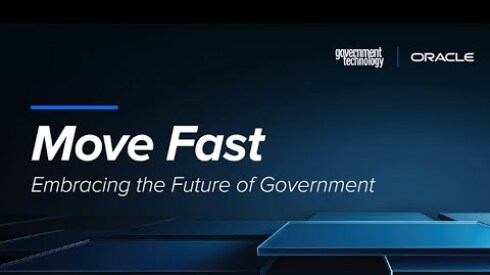Sponsored Articles
Sponsored
DuPage County's seamless dispatch system boosts 911 response efficiency, integrating 62 agencies for faster, coordinated emergency services.
Sponsored
A report on trends in the public sector reveals state and local government IT departments are looking to implement ITIL best practices and ITIL-aligned tools to better serve citizens.
Sponsored
The state used AI/ML-driven identity verification software to fight fraud and deliver nearly $1 billion in post-COVID-19 mortgage relief.
Sponsored
The emerging state of AI-focused legislation, two primary challenges AI presents, and controls that help agencies achieve legislative compliance.
Sponsored
Modern identity technology strengthens fraud protection for the state’s online motor vehicle portal and saves residents a projected 157,000 hours of friction annually.
Sponsored
Learn how the convergence of self-service and automation in public-sector IT enhances efficiency for government agencies — streamlining access to services, freeing up resources and fostering innovation.
Sponsored
New research shows reliance on outdated identity verification methods.
Sponsored
Contact centers are essential to creating a satisfying customer experience (CX) for government agencies and their constituents. In this Government Technology Q&A, Jerry Dotson, vice president of public sector, Avaya Government Solutions, explains how the right CX platform lets government organizations implement new contact center technologies easily and efficiently.
Sponsored
Other forms of digital ID will also be important for serving constituents online and preventing fraud.
Sponsored
The public sector faces some unique challenges when it comes to IT management. Here’s what government IT organizations are doing to tackle problems and deliver a great user experience.
Sponsored
It’s time for state and local governments to move fast and embrace change. To overcome challenges with legacy systems, public sector IT leaders must foster a culture of innovation, implement flexible cloud solutions, and improve the way they deliver services to their constituents.
Sponsored
Upgrading your ITSM tool can boost efficiencies, save money and result in better service delivery for end users.
Sponsored
A study found public-sector IT struggles with automation and ITIL. Learn how to tackle these challenges and gain insights into what other public-sector IT leaders are doing to solve these problems.
Sponsored
State and local governments face ongoing workforce challenges, including budget constraints and difficulty competing with the private sector. Often, antiquated technology and outdated processes make it even harder to attract and retain new employees.
Sponsored
To optimize business systems and deliver value to taxpayers, governments should focus on a modular strategy that allows them to stack solutions and applications that work together seamlessly — without having to overhaul all their business systems at once.
Industry Q&As
Sponsored
In this Q & A, Peter Romness, Cybersecurity Principal, US Public Sector CTO Office, Cisco Systems, and Steve Caimi, Public Sector Cybersecurity Specialist, Cisco, describe how zero-trust strategies can guide how leaders think about securing citizen data.
Sponsored
Nearly 150 state and local government leaders recently cited their biggest hurdles and top plans around cybersecurity in a recent Center for Digital Government survey.
Sponsored
In this Q&A, Cisco’s Global Industry Solutions Executive and Global Water Business Lead Sielen Namdar discusses ways that digitizing water systems can help utilities and governments enhance service and ensure safety throughout the entire water cycle.
Sponsored
In this Q&A, Mary Schlegelmilch, Cisco Education Advocate, and Brad Saffer, Global Education Lead, Cisco Industry Solutions, discuss ways that community colleges can leverage new models and technologies to help students reskill in the wake of the pandemic.
Sponsored
In this Q&A, Mary Schlegelmilch, Cisco Education Advocate, and Brad Saffer, Global Education Lead, Cisco Industry Solutions, discuss what Schlegelmilch calls an unprecedented opportunity “to reimagine what education can and should look like.
Sponsored
In this Q&A, Michelle Maggiore, Cisco Business Development Manager for the Transportation Industry Solutions Group, describes how a new concept of mobility has emerged and details strategies to help governments address it.
Sponsored
New technologies and a nimbler mindset have transformed how states and localities address disruption.
Sponsored
In this Q&A, Matt Lawson, principal architect for state and local government and education at NetApp, discusses strategies to meet evolving data management needs over the next 18 to 24 months.
Sponsored
In this Q&A, Cisco Senior Vice President Nick Michaelides and Marcus Moffett, Senior Director, Engineering and Architectures, address how governments will deliver increasing numbers of digital citizen services and attract, support and retain the next generation of employees.
Sponsored
The below article is an edited version of the interview between Justin Marlowe, research professor at the University of Chicago’s Harris School of Public Policy and senior fellow for the Center for Digital Government, and Joe Morris, vice president of research for the Center for Digital Government.
Sponsored
The COVID-19 pandemic was a wake-up call for government organizations that rely on legacy unemployment insurance systems.
Sponsored
How Amazon and DLT can help schools rapidly move from legacy infrastructure
Sponsored
Government finance leaders must look to digitization and emerging technologies to increase efficiency and productivity in a changing environment. Find out more in this video.
Sponsored
Government supply chain executives must develop a long-term strategy to manage the complexity and cost of logistics in a dynamic environment. Find out more in this video.
Sponsored
Wildfires, hurricanes and a global pandemic are just a few of the disasters plaguing parts of the country today, causing significant human and economic loss. Find out how to best address crisis planning from emergency response and recovery through resiliency.




























